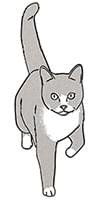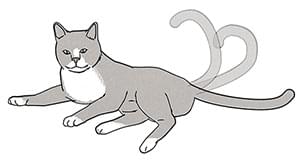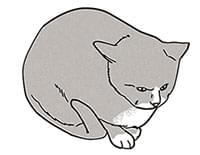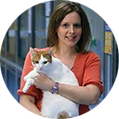What does it really mean when your cat has their tail up, down or swishing around? Behaviourist Justine Harding decodes their revealing tail signals.
Our cats express themselves in many ways, but it’s not always easy to decipher what they’re saying! Feline body language can often be misinterpreted, so learning to read their postures and movements, including cat tail signals, can help you to understand their moods and emotions.
Our cats’ solitary wild ancestors principally used scent to communicate. But as cats gradually became domesticated, they learned to live in closer proximity to other cats, as well as humans, and visual signals became more important. Highly mobile and expressive, a cat’s tail is a great signalling tool. Learning how to read a cat’s tail movements can help us understand what our pets are feeling or intending.
Let’s look at three common cat tail signals that all owners will be familiar with, and what these can mean.
Cat tail up

The best-understood cat tail signal is probably a tail held up vertically, sometimes with the tip slightly curled, like a question mark. To help understand cat tail language, one researcher from the University of Southampton presented cats with life-sized cat silhouettes with their tails in different positions. When the image showed the cat’s tail up, the real cats approached more quickly, and frequently reciprocated the signal. In effect, an upright cat tail says ‘I’m friendly’, thereby reducing the risk of a fight. If your cat greets you or other cats in your household with their tail up, it’s a clear sign of confidence, friendliness and affection.
Cat waving tail from side to side
Cat tail movements can also tell us about how our felines are feeling. Strong movement often signals strong emotions. So, if your cat’s tail is lashing from side to side and thumping on the ground, this indicates that they are highly agitated, and it’s probably best to leave them well alone.

Watch out, too, for a fluffed-up cat tail – this is a defensive reaction to make the cat appear bigger. A furiously waving tail can occur during play or hunting (positive emotion) or due to frustration and anger (negative emotion). Either way, your cat is charged and ready to act.
Conversely, soft, fluid cat tail movements suggest a lack of tension. So, a cat tail waving slowly from side to side may indicate a less urgent conflict, like indecision. Take note of your cat’s environment and their overall body language and vocalisations to get a clearer indication of the message intended.
Cat tail wrapped or tucked
Cats that are feeling relaxed appear loose and open, whereas a cat that does not wish to interact will withdraw. In terms of cat tail language, this is most clearly indicated when a cat’s tail is wrapped around their body or tucked underneath them, instead of lying loose on the ground, extending away from their body. Your cat may just want a cosy snooze or be a bit chilly, but a wrapped tail can sometimes signal stress and anxiety.

To decide what’s going on, consider the whole picture and setting. Is your cat snuggled down with their nose tucked in, for warmth? Or is their tail held tightly around their body or awkwardly just above the ground, indicating tension? Do their eyes appear soft and blinking (relaxed) or wide and staring (aroused)? Pay attention, too, when your cat moves – a tail tucked between their hind legs can suggest they feel threatened and may lash out.
Although your cat’s tail provides some excellent clues to what’s going on inside their head, it’s important to remember that ‘reading’ just their tail is like picking odd words out of a sentence – you could easily misinterpret what’s being said. You will get a greater understanding of your cat’s mood and emotions by observing their tail movements alongside their entire body language and the environment they are in.

Do you think we’re doing a good job? If you do, please vote for us in this year’s Insurance Choice Awards. Plus, you’ll also be entered into a prize draw to win £1,000 (Ts&Cs apply)
